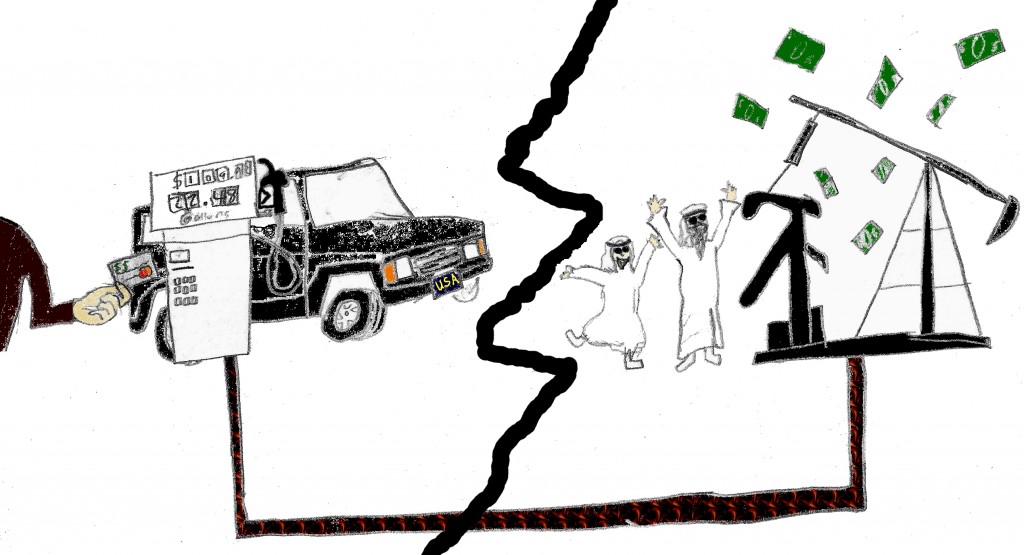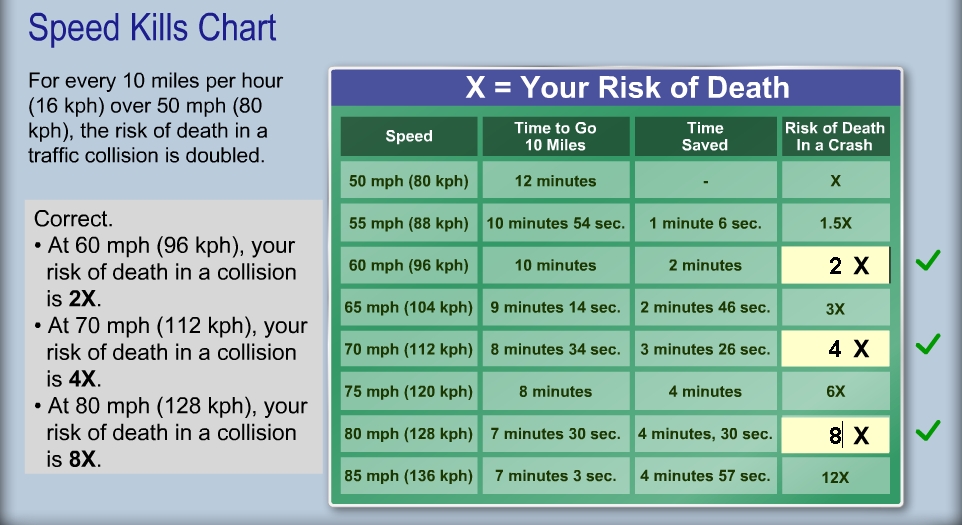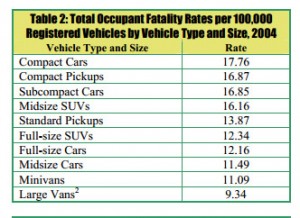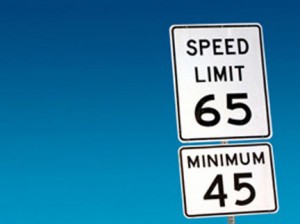This is Ecomodder.com.
If you are reading this, you are probably already well aware of the effect that speed has on gas mileage, and you are probably aware of the affect that fuel use has on the environment, national security, and your own wallet.
But in my time in the forums it has been clear that not everyone fully realizes just how dramatic an effect speed has on fuel use, not to mention safety, nor how tiny an effect it has on travel time. And of course, we all sometimes forget to apply things we already know in daily life.
If this is all review for you, consider this a friendly reminder.
First, a short history lesson:
In October of 1973 a group of nations got sick of the US “foreign policy” of military intervention, and, knowing we had developed a lifestyle totally dependent on oil, they all agreed not to sell us any more.
This caused massive and immediate affects throughout the US economy. Buying fuel, at any price, meant waiting in long lines – on those days you were even allowed to buy gas at all*
The government took steps to encourage conservation – which (unlike sourcing new oil) could be done immediately – such as banning Christmas lights.
Another major step they took was to enact a national speed limit of 55mph.
The reason for this is that at higher speeds air resistance increases exponentially** relative to speed. Going twice as fast requires 4 times the energy. This is as true of modern vehicles as it was in 1973. It will always be true, because it is due to fundamental physics. All vehicles, small or large, gas or alternative fuel, use more energy at speeds above 45mph.
In fact, going from 55 to 70mph typically uses between 20% and 25% more fuel to go the same distance.***
25% is a massive amount more fuel to use – at our current national usage, that amounts to approximately 5 million barrels of oil every single day!
That’s 175 million gallons.
That just happens to almost exactly equal the amount we purchase from the Middle Eastern OPEC nations.
In other words, if we still had (and actually enforced!!!!) a 55mph national speed limit today, that alone would completely eliminate any need for importing oil from the Middle East.

Guess it turns out congress occasionally does something sensible, eh?
Next, a physics lesson:
Similar to the relationship between wind resistance and speed, kinetic energy varies with the square of speed.
Energy=1/2 mass X velocity2Â ****
This means that if you are going twice as fast, it will take four times as much force to stop.
In other words, it will take four times the braking distance to stop in an emergency.
If it takes four times longer to stop, you are much more likely to slam into something full force which, at a lower speed, you could have come to a full stop in time to avoid hitting at all.
It also means that if you do end up in a crash, at twice the speed you will have four times the impact force.
At four times the impact, crumple zones and airbags can’t stop your organs from hitting your ribs hard enough to literally explode.
The energy in the previous equation dictates how hard you hit. Whatever energy isn’t absorbed by the car and restraints, gets absorbed by you.
A lot of people focus on the size of the car or truck they are in, believing a large amount of vehicle mass will absorb more crash energy.
Look at the formula:Â that’s half true.
Literally.
The affect of mass gets divided by two.  But velocity is not only factored in fully, it is squared. In plain English, this means that speed plays an overwhelmingly larger role in how bad a crash is than mass.
And incidentally, going back to the first point – a smaller car has a shorter braking distance at any speed, and so is less likely to crash into anything in the first place. Ask yourself: Which would you rather do, crash and survive, or not crash in the first place? This is why crash test ratings do not reflect safety – they only tell you if you will survive a crash, as though a crash were inevitable. They aren’t. And as it turns out, drivers of mid-size sedans actually do have less fatalities than drivers of full-size SUVs (along with all other sizes of SUV, all sizes of truck, and even heavier full-size cars. All of these are statistically more dangerous than mid-size cars, which should be more than enough to dispel the myth that heavy=safe, if only people knew the statistics) .
Buying a big vehicle, and then driving it fast is like getting a diet soda with your super-sized burger and fries.
I realize that almost everyone actually feels they are safe when they are driving a car.
It is human nature to take anything which is commonplace for granted. We tend to fear things which have an infinitesimally remote chance of happening but receive lots of news coverage but not think about things that really are likely to kill us, but which we don’t hear a lot about.
The number one cause of death of all young people in the US in car crashes. It causes more deaths among young people than murder, suicide, cancer, and heart disease combined. It is the number one cause of death up until age 40, at which point it is still in the top 3.
We don’t hear about it much in the news precisely because it is so common. There are roughly 16,500 accidents significant enough to be reported in the U.S. EVERY DAY. Of these, roughly 1/3 to 1/2 result in permanent injuries. Every 12 minutes, an American dies in a car crash.
Every time you get into a car, you may die.
The number one factor in causing all of these deaths and injuries? It isn’t alcohol. It isn’t teen drivers or cell phones.
It’s speeding.
Speeding is the single largest factor in injury and fatality collisions.
Contrary to popular belief, driving slower is safer even when other cars around you are speeding.*****
Here are two different studies’ conclusions on the issue, after compiling actual accident data:
And finally, a chart from the DHS defensive driving course:

So, ok, by now you are accepting the physics and the statics, and acknowledging that maybe there is a legitimate reason for speed limits, and a very real cost – environmentally, financially, and in lives – to breaking it.
“But… but…
I’m running late!!!!!!!!!!!”
The catch:
There is, of course, an obvious drawback to driving slower: it takes more time to get somewhere.
That is, of course, why people do it. Who wants to spend more time than they have to sitting in a car?
Time for just a little more math:
Time = Distance / Speed
What does this mean for typical driving speeds? Here, I’ll do the calculations for you:
1 hour = (60min x 60sec) = 3600seconds
3600 seconds / 65mph = 55 seconds
It takes 55 seconds to go one mile at 65mph.
3600/55mph = 65 seconds
1 mile at 65mph= 55seconds
1 mile at 55mph= 65seconds
Difference = 65-55 = 10 seconds
Slowing down from 65mph to 55mph means it will take you an additional 10 seconds to go a mile. Ten seconds. That’s it.
Speeding up from 65 to 75 would only gain 7 seconds. Going from 75 to 85 saves 6 seconds. The faster you go, the less time it saves.
Of course, going even one mile per hour over the posted speed limit is a crime. This is not an opinion, nor is it open to interpretation. It doesn’t matter if law enforcement chooses not to enforce the law, nor does it matter if “everyone else is doing it”. Speeding is, in addition to wasting money, natural resources, and human lives, is also illegal, and is totally unacceptable. Therefore I’ll limit the discussion to whether one drives as fast as legally possible, or slower than that. Going 10 miles per hour below the posted maximum is legal in every state in the country (in states that specify a minimum at all, it is 15 to 20mph below the maximum).
But when you are tempted to go above the limit, remind yourself that the faster you go, the less time you save. You can do the math yourself if you have trouble believing that.
A typical drive is 10 miles. Over a 10 mile drive by driving at the legal maximum instead of 10 under, you will waste 25% more gas (increasing your gas bill by 25%), and increase your risk of death by 60-100%, all to save just a minute and a half. A minute which you may well end up losing again at a single stop light. I’m sure you have been passed by a speed demon only to catch up to them a minute later at the red light they raced to (or are you always that speed demon? Either way, you know what I mean). I find that even at 20mph under the limit, the ETA estimates that Google Maps and my GPS unit give me are always spot on, if not slightly late. Both systems assume I will drive at the speed limit, and calculate how long the trip should take based on that. I often get where I am going sooner than they said I would, even though I drive slower than they expect.
Even on a long drive, say 350 miles from SF to LA, speeding the entire way only saves a little over a half an hour.
That half an hour meant using up an extra 3 gallons of gas, or almost $11. According to the study quoted above, you also increase your risk of death by up to 100%.
But wait!!!
Here is a real-life story, written by “CBR Shadow”:
” I recently took an 800 mile trip with a friend in my car [A Honda Insight] and we averaged 74mpg on the highway with some hypermiliing techniques (slow lane, try to get behind a truck, etc). I got behind a full car carrier truck (the holy grail for hypermiling on the highway IMO) and stayed behind him for 50 miles averaging 94MPG!!!
The best part of that trip is that my brother … drove his Nissan Xterra on the same route and left at the same time as us. He laughed before thet rip about how he’s going to get there way before us because I’m such a penny pincher. Ends up we beat him there by 5 minutes! He stopped twice for gas and stopped for food twice, where we stopped for gas once (almost didn’t have to at all!) and brought food in the car. My brother spent $135 in gas for that trip, where my friend and I split a $40 gas bill :)” [Emphasis mine]
I am not asking you to give up your car and rely solely on bicycles and public transportation.
I am not asking you to buy an experimental electric or alternative fuel car, an expensive new hybrid, or even a smaller more efficient car.
I am not suggesting you go to the lengths I do and remove your power steering pump and alternator, or drive 45mph on the freeway.
All I am asking is that you slow down. Never, ever, ever exceed a posted speed limit on a highway.******
Leave home on time so you don’t have to rush. It is not up to you to regulate everyone else, so stay in the right lane. Don’t worry about people who pass you. It is not a race. On rural roads be courteous and use turn-outs; but don’t let obnoxious impatient people pressure you into risking a traffic ticket or fatal accident – just move to the right, put on your flashers, and encourage them to pass. On a freeway there are always at least 2 lanes, so there is no excuse for anyone behind you not to pass if they want to go faster.
If you value your own money.
If you value the environment.
If you value national security and energy independence.
If you value the lives of those around you.
If you value your own life.
You don’t even have to care about all of those things. Any one of them of them is reason enough.
Leave the house 1 and a half minutes sooner, and slow down.
This will not, all by itself, save the world. But if we all do it, it will make a difference.
Thank you.
“No one can cut you off if you choose to slow down and let them in”
*hmm, so maybe Soviet era lines for goods were not caused by the distribution system of communism, but by a plain lack of resources…
**Disclaimer for math and physics people: I know, technically the curve is parabolic, not exponential, but if I used that term no one would know what I was talking about
***You don’t have to take my word for it:
http://en.wikipedia.org/wiki/Fuel_economy_in_automobiles#Speed_and_fuel_economy_studies http://www.fueleconomy.gov/feg/driveHabits.shtml
http://eartheasy.com/live_fuel_efficient_driving.htm
http://www.lawcore.com/car-accident/statistics.html
http://casr.adelaide.edu.au/speed/exec.html
http://www.tsc.berkeley.edu/newsletter/winter2008/speed.html
****Mass means the total weight of the car (plus passengers and cargo, etc). Velocity is basically a fancy word for speed.
*****The chance of an accident is higher if you go slower than traffic around you, because of the speed deferential. This is (unfortunately) even occasionally pointed out in some driving courses. But the chances of a FATAL accident, or even an injury accident, go up with speed, as noted above. Which would you rather avoid: a low speed fender bender, or death?
******Don’t speed on the streets either – you won’t save gas at 25mph, but you will avoid killing pedestrians and cyclists. Traffic engineers put speed limits in place for a reason. You aren’t a traffic engineer. Trust them on what speed is safe.
[post adapted from one on my personal blog, at http://biodieselhauling.blogspot.com/ ]
Popularity: 21% [?]








Comments on this entry are closed.